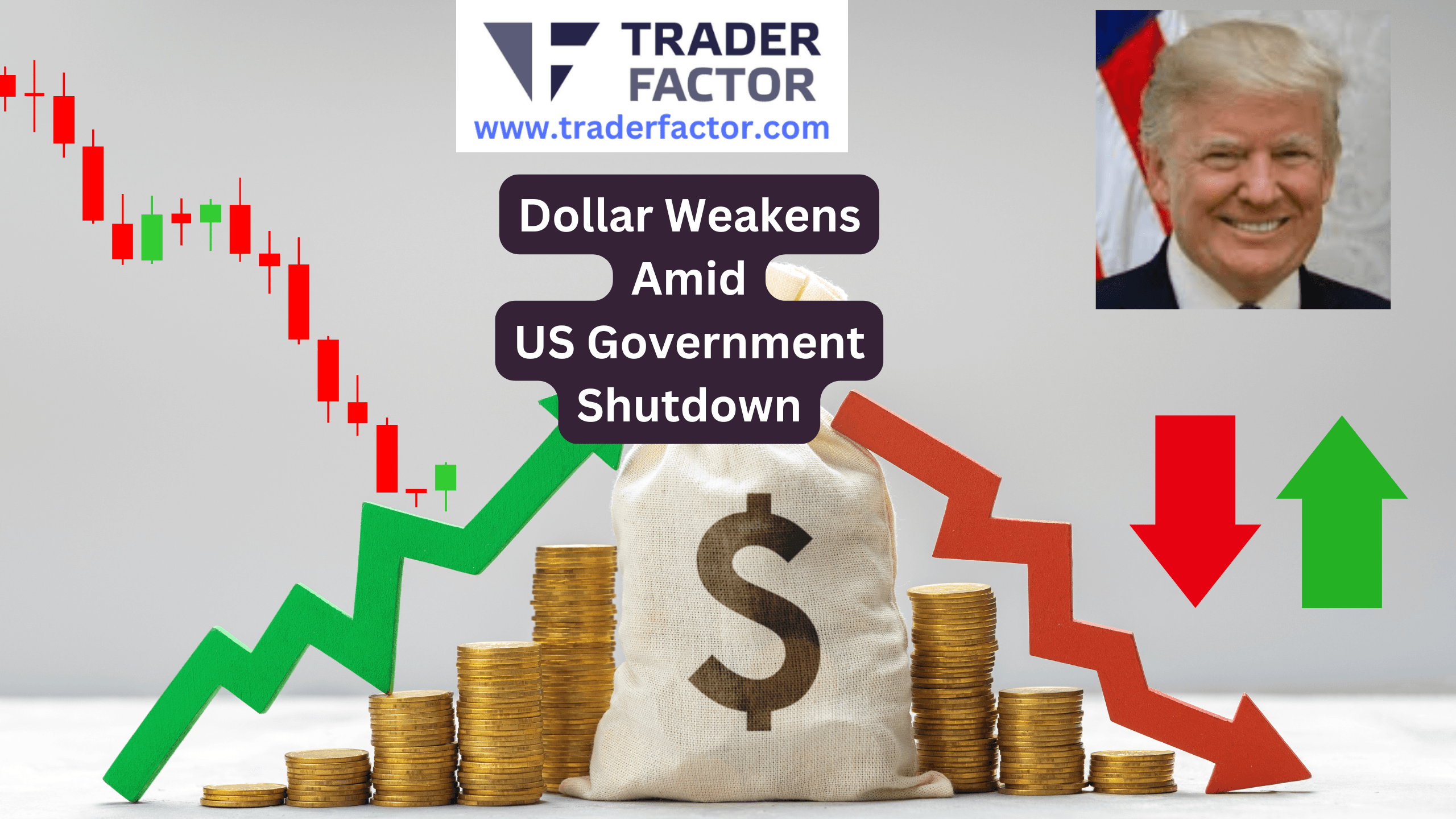Global financial markets are experiencing pronounced volatility as the specter of a US government shutdown draws closer. This week, traders are confronting a complex mix of fiscal uncertainty, critical economic data releases, and central bank decisions. A weakening US Dollar is driving trends across forex, commodities, and equity markets. At the same time, upcoming reports and policy announcements are likely to add further layers of risk and opportunity. This in-depth analysis examines the current landscape, incorporating key figures and forward-looking considerations for major asset classes.
Table of Contents
ToggleDollar Weakness Dominates Market Sentiment
The US Dollar heads into the week on fragile ground, weighed down by political risk as Congress struggles to reach consensus on budgetary issues. The Dollar Index (DXY) remains soft, hovering at 97.95. Political uncertainty is now being compounded by critical macro data releases, including the JOLTS job openings report due Tuesday, which is expected to reflect labor market tightness or reveal early signs of cooling. Furthermore, the highly anticipated Non-Farm Payrolls (NFP) data on Friday will be closely watched, with markets already pricing in the potential for a softer jobs number following mixed signals from earlier economic indicators. These events, taken together, are causing a rotation out of the greenback, as traders hedge against both political and economic headwinds.
US Dollar Index (DXY) Performance
The DXY’s broad-based weakness reflects mounting investor uncertainty. Concerns that a shutdown could delay economic readings such as the ISM Manufacturing PMI on Wednesday and the unemployment report on Thursday are further undermining confidence. If government operations halt, data dissemination will be disrupted, complicating monetary policy and market forecasting. At the same time, the impact of speeches scheduled from key policymakers, including those from the Federal Reserve and representatives from the Bank of Japan, Bank of England, and European Central Bank on Friday, will require close monitoring. Their remarks could provide clues about central bank responses to any potential disruption, potentially amplifying or reducing dollar volatility.
Forex Majors React to a Packed Economic Calendar
This week’s forex landscape is being shaped not only by US political instability but also by a string of global economic events and central bank decisions. Major pairs are moving sharply as traders digest the interplay of local fundamentals with the dollar’s weakness.
EUR/USD and GBP/USD React to Incoming Data
EUR/USD, perched near 1.1700, is being supported by broad dollar weakness but also faces a crucial test on Wednesday with the release of the Eurozone CPI report. Consensus forecasts call for headline inflation to remain elevated, likely reinforcing expectations for the ECB to keep a tightening bias. Any upside surprise could push the pair higher as it would suggest persistent price pressures in the bloc.
Meanwhile, GBP/USD is recovering and approaching the 1.3400 mark. The British pound’s outlook will also be shaped by key monetary policy commentary, including a scheduled speech from the Bank of England Governor on Friday. Markets are weighing if the BOE might signal a readiness to hold or cut rates amid slowing inflation and economic headwinds in the UK.
USD/JPY and USD/CAD Move on Oil and Policy Dynamics
USD/JPY is trading near 148.950, briefly dipping below the 149.00 level. The yen’s path forward is complicated by anticipation of comments from the Bank of Japan’s leadership on Friday. Markets are watching for any hints of policy normalization from the BOJ, as ongoing global risk aversion pushes flows toward the safe-haven yen.
USD/CAD is hovering at 1.39220, with the Canadian dollar drawing some support from stable oil prices—WTI crude is holding around $65.22. The cross will also be influenced by the outcome of the OPEC meetings beginning Wednesday, as any announcement related to production levels could spark volatility in energy-linked currencies.
AUD/USD and NZD/USD Under Watch with RBA and Global Data
AUD/USD is edging higher toward the 0.6600 thesis, with traders keenly focused on Tuesday’s RBA cash rate announcement. Consensus projects the central bank will hold at 3.60%, as Australian inflation has eased but wage growth remains robust. The RBA’s statement and guidance could introduce a sharp move in the Aussie, especially if language around future tightening shifts materially.
NZD/USD also remains in play, with the currency benefiting from the dollar’s weakness and relative resilience in New Zealand’s economic outlook. However, sentiment may be tested by global developments, particularly if risk appetite wanes amid disappointing US or Chinese data.
Commodities Await Supply, Data, and Monetary Signals
Commodity markets are at a crossroads this week, as both fundamentals and macro events are likely to drive substantial price action.
Precious Metals Rally As Uncertainty Reigns
Gold continues its ascent, trading just below $3,800 per troy ounce. Investors are flocking to the metal in the face of policy and political uncertainty. Meanwhile, silver is holding at $47.00, supported by similar dynamics and a weaker US dollar. These gains may be further boosted if upcoming US jobs data or policy statements reaffirm the case for lower US rates or ongoing political dysfunction.
Crude Oil and OPEC in Focus
WTI crude oil is relatively subdued at $65.22. Prices are being weighed by expectations ahead of the OPEC meetings which begin Wednesday. Markets anticipate OPEC+ will assess current supply discipline against the backdrop of uncertain global demand. A decision to maintain or cut output could generate a sharp move in oil prices, impacting not only energy equities but currencies like the Canadian dollar and Norwegian krone.
Equity Markets and Global Indices Display Cautious Optimism
Major US stock indices are holding firm despite the risk-off undertone, with the Nasdaq at 22,484, Dow Jones at 46,247, and S&P 500 at 6,643. Investors appear to expect that any government shutdown will be short-lived, or that underlying economic resilience—backed by strong Q2 earnings and relatively robust consumer spending—will buffer the impact.
However, several upcoming releases could challenge this optimism. The ISM Manufacturing PMI is due Wednesday, and any indication of contraction in US manufacturing could spook equities. Similarly, Switzerland’s CPI on Thursday may influence risk sentiment, especially for global investors who track inflationary trends in export-driven economies. Labor market data mid- and late-week, including the official US unemployment report and Friday’s NFP release, will be critical for shaping the outlook for both stocks and the Federal Reserve’s next steps.
Cryptocurrencies Hold Support Levels
Digital assets have stabilized after last week’s volatility. Bitcoin remains above $112,000 and Ethereum has regained ground above $4,120. These markets have so far decoupled from the direct influence of traditional macro events, although extreme moves in risk sentiment or deepening market turbulence could still spark correlation-driven volatility in crypto prices.
A Week Dense With Risk Events and Policy Moves
In summary, this is no ordinary week for global markets. Market participants must navigate not only the potential consequences of a US government shutdown but also process a barrage of economic releases and policy decisions globally.
Traders are watching the RBA’s Tuesday rate decision, the US JOLTS job openings and ISM Manufacturing reports, Eurozone and Switzerland CPI prints, as well as OPEC’s supply guidance. Central bank governors from the Bank of Japan, Bank of England, and ECB are set to speak Friday, and their comments may deliver critical direction for bond and currency markets. Finally, the culmination of the week comes with the release of NFP data, regarded as a bellwether for economic momentum and monetary policy in the United States.
Conclusion
This week features an extraordinary convergence of fiscal, economic, and policy uncertainty. The interplay among political gridlock in the US, high-impact data releases, and central bank decisions could define near-term direction for global financial markets. Vigilance is warranted, as conditions could shift rapidly in response to unfolding headlines and economic surprises.
Disclaimer:
All information has been prepared by TraderFactor or partners. The information does not contain a record of TraderFactor or partner’s prices or an offer of or solicitation for a transaction in any financial instrument. No representation or warranty is given as to the accuracy or completeness of this information. Any material provided does not have regard to the specific investment objective and financial situation of any person who may read it. Past performance is not a reliable indicator of future performance.

















